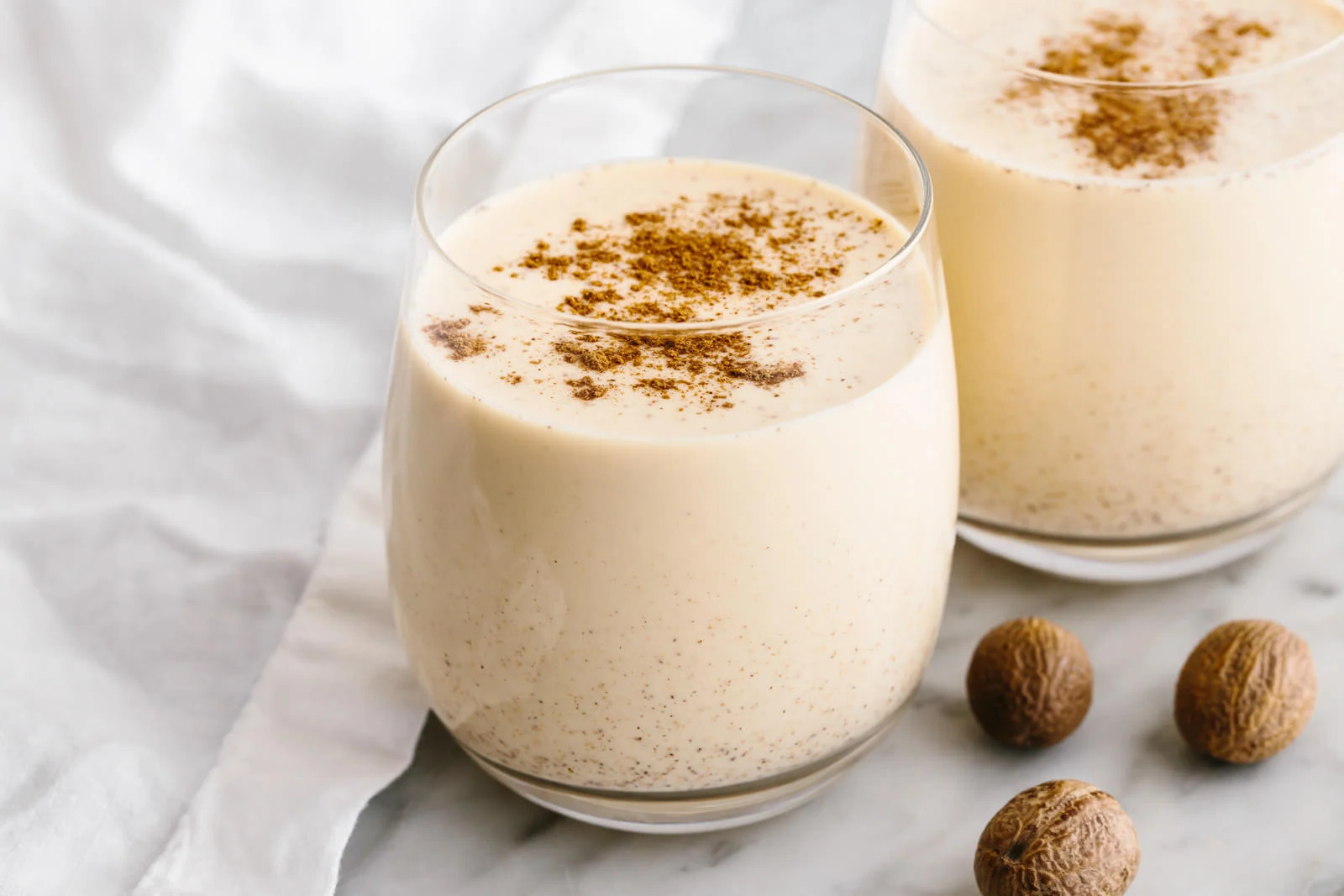Indulge in the creamy, festive delight of homemade eggnog. This classic holiday beverage is perfect for warming up your winter nights and bringing a touch of nostalgia to your gatherings. With a rich blend of milk, eggs, sugar, and a hint of nutmeg, this recipe is sure to become a seasonal favorite.
While most of the ingredients for this eggnog recipe are common pantry staples, you might need to pick up heavy cream and nutmeg if they aren't already in your kitchen. Additionally, if you choose to add a boozy twist, make sure to grab some rum from the liquor section.

Ingredients For Eggnog Recipe
Milk: The base of the eggnog, providing a creamy texture and rich flavor.
Eggs: Separated into yolks and whites, they add richness and help thicken the eggnog.
Sugar: Sweetens the eggnog and balances the flavors.
Heavy cream: Adds extra creaminess and richness to the eggnog.
Vanilla extract: Enhances the flavor with a sweet, aromatic note.
Nutmeg: Provides a warm, spicy flavor that is quintessential to eggnog.
Rum: Optional, but adds a festive, warming kick to the eggnog.
Technique Tip for Making Eggnog
When heating the milk in the saucepan, make sure to do it over medium-low heat to prevent it from scorching. Stir frequently and keep an eye on it to ensure it doesn't come to a boil. This gentle heating helps to maintain the integrity of the milk and ensures a smooth texture for your eggnog.
Suggested Side Dishes
Alternative Ingredients
milk - Substitute with almond milk: Almond milk provides a similar creamy texture and is a great option for those who are lactose intolerant or prefer a dairy-free alternative.
milk - Substitute with oat milk: Oat milk has a neutral flavor and creamy consistency, making it a good substitute for regular milk in eggnog.
eggs - Substitute with silken tofu: Silken tofu can be blended to create a smooth texture that mimics the consistency of eggs, suitable for a vegan version of eggnog.
eggs - Substitute with flaxseed meal: Mix 1 tablespoon of flaxseed meal with 3 tablespoons of water to replace one egg. This works well as a binding agent in the recipe.
sugar - Substitute with maple syrup: Maple syrup adds a natural sweetness and a hint of maple flavor, which complements the spices in eggnog.
sugar - Substitute with honey: Honey provides a natural sweetness and can add a slightly floral note to the eggnog.
heavy cream - Substitute with coconut cream: Coconut cream offers a rich and creamy texture similar to heavy cream, perfect for a dairy-free option.
heavy cream - Substitute with cashew cream: Cashew cream is another dairy-free alternative that provides a smooth and creamy consistency.
vanilla extract - Substitute with vanilla bean paste: Vanilla bean paste has a more intense vanilla flavor and includes the seeds from the vanilla pod, adding a gourmet touch.
vanilla extract - Substitute with almond extract: Almond extract can be used for a different but complementary flavor profile in the eggnog.
ground nutmeg - Substitute with ground cinnamon: Ground cinnamon offers a warm and spicy flavor that pairs well with the other ingredients in eggnog.
ground nutmeg - Substitute with allspice: Allspice provides a complex flavor that includes hints of cinnamon, nutmeg, and cloves, making it a suitable substitute.
rum - Substitute with bourbon: Bourbon adds a rich, smoky flavor that complements the creamy and spicy elements of eggnog.
rum - Substitute with brandy: Brandy offers a smooth and slightly fruity flavor, making it a good alternative to rum in eggnog.
Alternative Recipes Similar to Eggnog
How to Store or Freeze Eggnog
- Allow the eggnog to cool completely before storing. This prevents condensation, which can dilute the flavor and alter the texture.
- Transfer the eggnog to an airtight container. Glass jars with tight-fitting lids work best to maintain freshness and prevent any unwanted odors from seeping in.
- Store the eggnog in the refrigerator. It will keep well for up to 3-4 days. Always give it a good stir before serving, as some separation may occur.
- For longer storage, consider freezing the eggnog. Pour it into a freezer-safe container, leaving some space at the top for expansion.
- Label the container with the date to keep track of its freshness. Frozen eggnog can last up to 6 months.
- When ready to use, thaw the eggnog in the refrigerator overnight. After thawing, whisk it well to restore its creamy consistency.
- If you notice any changes in smell, texture, or taste, it's best to discard the eggnog to ensure safety.
How to Reheat Leftovers
- Gently reheat the eggnog on the stovetop over low heat, stirring constantly to prevent curdling. This method ensures the eggnog retains its creamy texture.
- Use a double boiler to reheat the eggnog. Place the eggnog in a heatproof bowl over a pot of simmering water, stirring occasionally until warmed through. This indirect heat method helps maintain the delicate consistency.
- Microwave the eggnog in short intervals. Pour the eggnog into a microwave-safe container and heat on medium power for 30 seconds at a time, stirring in between to ensure even heating and prevent overheating.
- If you prefer a frothy texture, use a milk frother to reheat and froth the eggnog simultaneously. This method adds a delightful airy quality to the drink.
- For a quick and easy method, use an immersion blender to reheat the eggnog. Place the eggnog in a pot and blend while heating over low heat. This method ensures even heating and a smooth texture.
Best Tools for Making Eggnog
Saucepan: Used to heat the milk until warm and later to cook the egg mixture until thickened.
Mixing bowl: Used to whisk the egg yolks and sugar until creamy and to beat the egg whites until stiff peaks form.
Whisk: Essential for whisking the egg yolks and sugar, as well as for incorporating the warm milk into the egg mixture.
Spatula: Useful for folding the beaten egg whites into the cooled mixture.
Measuring cups: Necessary for accurately measuring the milk, sugar, heavy cream, and optional rum.
Measuring spoons: Needed to measure the vanilla extract and ground nutmeg.
Stove: Required to heat the milk and cook the egg mixture.
Refrigerator: Used to chill the eggnog before serving.
Serving glasses: For presenting the chilled eggnog to guests.
How to Save Time on Making Eggnog
Prepare ingredients in advance: Measure and separate eggs, sugar, and milk beforehand to streamline the process.
Use a stand mixer: A stand mixer can quickly whisk egg yolks and sugar, and beat egg whites to stiff peaks, saving you time and effort.
Heat milk carefully: Warm the milk on low heat to avoid curdling, allowing you to multitask without constant supervision.
Chill faster: Place the eggnog mixture in a shallow dish to cool it more quickly before adding the cream and vanilla.
Skip the rum: If you're in a hurry, omit the rum to save a step and still enjoy a delicious eggnog.

Eggnog Recipe
Ingredients
Main Ingredients
- 4 cups Milk
- 5 Eggs separated
- ¾ cup Sugar
- 1 cup Heavy cream
- 1 teaspoon Vanilla extract
- ½ teaspoon Nutmeg ground
- ¼ cup Rum optional
Instructions
- In a saucepan, heat milk until warm.
- In a bowl, whisk egg yolks and sugar until creamy.
- Slowly add warm milk to egg mixture, whisking constantly.
- Return mixture to saucepan and cook until thickened.
- Remove from heat and let cool. Stir in cream, vanilla, and nutmeg.
- In a separate bowl, beat egg whites until stiff peaks form.
- Fold egg whites into cooled mixture. Add rum if desired.
- Chill before serving.
Nutritional Value
Keywords
More Amazing Recipes to Try 🙂
- Slow Cooker Chili Recipe8 Hours 15 Minutes
- Summer Squash Bread Recipe1 Hours 15 Minutes
- Apple Cider Recipe40 Minutes
- Watermelon Lemonade Recipe10 Minutes
- Electric Lemonade Recipe10 Minutes
- Turkey Wraps Recipe10 Minutes
- Fresh Banana Daiquiri Recipe10 Minutes
- Cosmopolitan Recipe5 Minutes

Leave a Reply